Jan 05, 2009
Yesterday Was Cold. Tomorrow is Going to be Positively Arctic
By Paul Simons, Times Online UK
The big freeze will envelop the South tonight as the Arctic weather conditions send temperatures plunging as low as minus 10C (14F).
Scotland has borne the brunt of the cold weather so far, but Met Office forecasts suggest that England and Wales are about to suffer the worst temperatures, with a similar freeze on Wednesday night across Wales and southern England. Even during the day, temperatures are unlikely to stay above freezing in many places.
To add to the misery, a belt of sleet and snow showers running down through East Anglia and the South East could leave 1cm (0.4in) of snow on the ground this morning. It could also wash away the grit spread by councils during the night and leave widespread ice on roads and pavements during the morning rush hour.
This brief shower aside, conditions are set to remain dry in what is becoming a very dry winter. However, with such thick frost expected this week it could look like snow first thing in the morning. And because conditions are also calm, with hardly a whiff of a breeze, there will be plenty of dense freezing fog hanging around. This can produce the strange sight of ice crystals falling out of the air and settling on the ground, which can look like snow has fallen.
Extreme cold such as this is often seen in the glens of the Highlands during winter, but is more unusual farther south. The coldest temperature in England last winter was minus 10C at Copley, Co Durham, in February, but the cold was not as widespread, nor as prolonged, as the present bout. Mid-January is often the coldest time of the year, even though the daylight is growing longer, as an old saying goes: “As the days grow longer, the cold grows stronger.” This is because the seas around Britain take a long time to lose their heat stored up from last summer and, as they grow colder through January, they give less insulation from cold blasts of air sweeping down from the North or East.
The problem this winter is that the weather is stuck in a rut. For weeks, high pressure has sat over or very close to the UK, blowing a steady stream of cold air off continental Europe and trapping the cold down on the ground. Because this type of weather blocks out our usual wet but mild Atlantic weather it is called a “blocking pattern”, and is difficult to budge.
There are signs that by the end of this week the high pressure system may start to slip southwards and open the door for Atlantic depressions to roll back in, bringing a welcome blast of mild, but wet air. And the Met Office still stands by its long-range forecast of a milder end to the winter.Even if this winter proves to be the coldest for many years, both here and in other regions of the world, it makes little difference to the overall trend in global climate. The weather can fluctuate wildly from year to year, but the big picture becomes clear only over decades and centuries.
Even in medieval times, when the climate in Europe was fairly benign, there were some astonishingly brutal winters. In 1205, for example, the Thames froze from mid-January until March. As one chronicler recorded: “No ground could be tilled, and frozen ale and wine were sold by weight.” Read more here.
Another busted UKMO forecast this year. And now they point to cold spells even in the Medieval Warm Period. I guess even they regard Mann’s hockey stick to be a fantasy. Ironically the cold of the last two years has forced them to admit the importance of La Nina and El Nino to climate. Now if they would also recognize the importance of the PDO which causes a predominance of La Ninas for decades at a time (since 1998 and back from 1947 to 1977) and El Ninos at other times (1979-1998). It is a true climate driver capable of overwhelming any of man’s influences, especially greenhouse gases.
Jan 05, 2009
Global Warming Unlikely Reason for Slow Coral Growth
By Jennifer Marohasy
Researchers in Australia say the growth of coral on the country’s iconic Great Barrier Reef (GBR) has fallen since 1990 to its lowest rate in 400 years, variations of this message have been repeated around the world from South Korea to London with global warming, and the associated acidification of oceans, claimed to be the cause. These reports are repeating claims in an Australian Institute of Marine Science (AIMS) media release made just last Friday to coincide with the publication of research findings in the journal Science.

The media release also claimed the research to be “the most comprehensive study to date on calcification rates of GBR corals”. Having followed GBR issues for many years I was surprised to hear global warming associated with slow coral growth rates, indeed AIMS’s researchers Janice Lough and David Barnes have published detailed studies concluding that coral growth rates increase significantly with an increase in annual average sea surface temperature.
Furthermore growth rates actually decrease from north to south along the GBR as this corresponds with a cooling temperature gradient of 2-3 degrees C. If there has been a slowing in growth rates of coral over the last nearly 20 years, as suggested by this new research, a most obvious question for me would be: Have GBR waters cooled?
This new research paper in Science presents evidence for a decline in coral growth rates since 1990, but no credible reason for the decline. While the study hints that the cause could be ocean acidification no direct evidence is provided to support this claim - not even a correlation. Indeed no data is presented to suggest the PH (a measure of acidity) of GBR waters has changed, and based on modelling of hypothetical changes in PH associated with increases in atmospheric carbon dioxide there is a timing problem - the decline in calcification rates should apparently have started years earlier.
Confronted with a lack of evidence in support of this hypothesis - that ocean acidification has caused the drop in growth rates - the researchers suggest in the paper “synergistic effects of several forms of environmental stress” and implicate higher temperatures. But no data is presented in the paper to contradict the well established relationship between increasing temperature and increasing growth rates - though various confusing statements are made and it is suggested that global warming has increased the incidence of heat stress in turn reducing growth rates - while at the same time the researchers acknowledge higher growth rates in northern, warmer, GBR waters.
Marine Biologist Walter Starck has perhaps aptly described the research as part of “the proliferation of subprime research presenting low value findings as policy grade evidence” and has suggested this has “science headed in the same direction as Wall Street.” Read full post and more here
See this analysis by John McLean of ocean temperatures on the Great Barrier reef here. See this post here and a site full of information here.
Jan 04, 2009
Where Thermometers Go To Die - How Not to Measure Temperature
By Anthony Watts, WattsUpWithThat
In my 30 years in meteorology, I never questioned how NOAA climate monitoring stations were setup. It wasn’t until I stumbled on the Marysville California fire station and its thermometer that that I began to notice just how badly sited these stations are. When I started looking further, I never expected to find USHCN climate monitoring stations placed at sewage treatment plants, next to burn barrels, or in parking lots of University Atmospheric Science Departments, or next to air conditioning heat exchangers. These were all huge surprises. I didn’t think I’d be surprised anymore. I thought I’d seen the weirdest of the weird, and that I would not be surprised again with bad station placement examples. Then I saw this station, submitted from Fort Scott, Kansas:
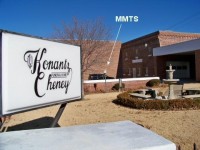
Yes, your eyes do not deceive you. That is an official NOAA USHCN climate monitoring station at a funeral home in downtown Fort Scott, KS. From a wider perspective, you can see all the things around it. Not only do we have a fountain (extra humidity), a nearby brick wall, a large concrete driveway that curves around the station, a tree for shade in the late afternoon, a big brick building with a south facing brick wall, but we also have cobblestone streets and convenient nearby parking. This location has everything needed, except a BBQ. See the complete photo gallery here. It seems that that station was moved into this location from the previous one about a block away on April 4th, 2008. Upon first examination. it appears that it “may” have been cooler at the previous location, once you get past the spike of the 1998 El Nino it seems the elevated step function remains. Though since the location was also downtown, about a block away, perhaps the UHI of the downtown has overwhelmed the station change.
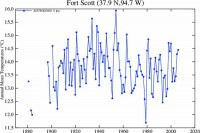
Larger image here
From what I can tell of the towns history, most of the growth in buildings occurred during the first half of the 20th century. Many of the downtown buildings seem to date from that time. Certainly it appears cooler around 1900. No worries though, GISS has “fixed the temperature to reflect a cooler past:
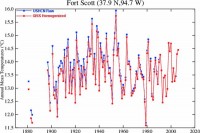
Larger image here
“A beautifully undulating prairie”. “An almost precipitous decent of fifty feet”. “A flat spur of high prairie”. “A small clear-water creek”. In 1852, Assistant Surgeon Joseph Barnes used all of these phrases to describe the landscape surrounding Fort Scott. Yes it probably was cooler in Fort Scott’s past, when it looked like this, when it was founded:
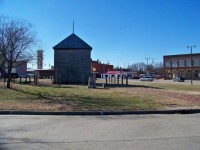
Read full post and comments here.
Jan 04, 2009
Cross Country Race Canceled Because of Frigid Cold
AP News in the International Herald Tribune
Frigid temperatures forced organizers of the U.S. Cross Country Championship sprint race to cancel the event Saturday. Race organizers hoped to hold the sprint races on Sunday, if the cold snap that has gripped much of Alaska for the past week loosens its grip a bit. Forecasters, however, said the bitterly cold weather was expected to continue.
After several delays in which race organizers kept an eye on the temperature, the race at Kincaid Park was canceled mid-afternoon. Organizers watched as the mercury rose from 13 degrees below zero to about 6 below zero. In the end, it wasn’t enough, said race spokesman John Quinley. The cutoff for running the race is 4 degrees below zero.
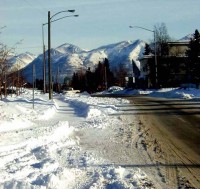
Quinley said the event has been rescheduled for Sunday with an 11:30 a.m. start. Quinley also said the athletes were disappointed, but the temperature was still too cold and the sun was starting to go down. “They were disappointed,” Quinley said. “They were primed and ready to ski.”
Over 400 skiers are competing in the U.S. Cross Country Championship, now scheduled to be held from Sunday through Thursday. Anchorage’s Kikkan Randall, the best cross country skier in the nation, is competing, as well as many of the country’s top college skiers. Quinley said if Sunday also is too cold, it is possible to run the different events from Monday through Thursday with no rest days. Katie Ronsse, 23, a graduate of the University of Denver, is living in Anchorage and training at Alaska Pacific University, where Randall trains. She said when the skiers arrived at Kincaid Park on Saturday morning the temperature was 15 degrees below zero.
“It did warm up after the sun came out. It looked hopeful but it wasn’t quite warm enough,” she said. Tyson Flaharty, 23, of Fairbanks, said he’s used to training in much colder weather. “I don’t really mind the cold,” he said. “It doesn’t seem like it is that cold and the race would have been fun.” Temperatures in Fairbanks were 40 below on Saturday afternoon. Forecasters said it would dip to 50 below over the weekend.

Read story here.
See also this story out of Anchorage on the frigid weather.
Jan 02, 2009
Quantifying the US Agricultural Productivity Response to Solar Cycle 24
By David Archibald
In 2006, The National Arbor Day Foundation updated the 1990 US Department of Agriculture map of plant hardiness zones for changes in the annual average minimum temperate over the intervening sixteen years (larger image here) from Arborday.org.
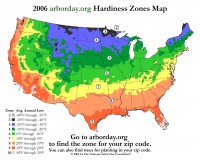
Relative to the location of the zones in the 1990 USDA map, hardiness zones have shifted northward by the following amounts relative to the latitude band:
30 N 110 km northward shift
35 N 200 km northward shift
40 N 280 km northward shift
The improvement in growing conditions resulting from this northward shift in annual average minimum temperature caused an increase in agricultural productivity. Following is a graphic of the agricultural output of a number of US states accounting for 19% of US agricultural production:
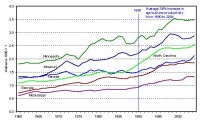
Larger image here.
It is apparent from the graphic that there was a step change in the rate of increase of agricultural production at about the time the USDA plant hardiness zone map was created in 1990. Over the subsequent fourteen years, agricultural production in these six states rose 34%. The USDA state productivity data is available here. A proportion of the increase would have been due to the introduction of GM crops and other changes in agricultural practices. Nevertheless, the productivity growth is substantial and coincident with improved climatic conditions.
The change in plant hardiness zones over the 1990 to 2006 period is explained by solar cycle length changes. Solar Cycle 20 from 1964 to 1976 was 11.6 years long. Solar Cycle 21 was shorter than average at 10.3 years and Solar Cycle 22 from 1986 to 1996 was very short at 9.6 years long. There is a correlation between solar cycle length and temperature over the following solar cycle. In the mid-latitudes of the US north-eastern seaboard, this is 0.7 C for each year of solar cycle length. With the cumulative change in solar cycle length between Solar Cycle 20 and Solar Cycle 22 of two years, this would have translated to a 1.4 C increase in temperature by early this decade relative to early 1970s. This is reflected in the northward shift of plant hardiness zones as mapped by The National Arbor Day Foundation.
By virtue of a lack of Solar Cycle 23 sunspots, solar minimum of the Solar Cycle 23 to 24 transition appears to have been in late 2008. This makes Solar Cycle 23 three years longer than its predecessor. Consequently, using the 0.7 C per year of solar cycle length relationship, there will be a 2.1 C decline in temperature of the mid-latitudes next decade during Solar Cycle 24. Using the calibration provided by the climate shift caused by the Solar Cycle 20 to 22 change in solar cycle length, the following shifts in climatic zones, and thus growing conditions, are estimated:
30 N 160 km southward shift
35 N 300 km southward shift
40 N 420 km southward shift
Assuming that two thirds of the productivity increase in mid-western states from 1990 to 2004 was climatically driven, then the productivity decline in this region due to Solar Cycle 24 is expected to be of the order of 30%. The total US agricultural productivity decrease would be less than that at possibly 20%, equating to the export share of US agricultural production. See more here.
|











